
Choosing a lavatera
Our tips to make the right choice
Contents
Called also tree mallow or shrubby mallow, the lavatera belongs to the family of malvaceae. This large family includes hollyhocks or Alcea, which should not be confused with hibiscus or althaea, sensational with their brightly coloured flowers inserted on long stems, to which they resemble.
A star of gardens of yesteryear, the lavatera quickly forms charming flowering bushes: essential and ideal in cottage gardens or vicarage gardens. In all seaside gardens, shrub mallow has its place at the back of flower beds as well as in mixed borders and romantic flower beds. Discover our tips to help you choose among the different varieties of lavatera based on criteria such as size, flower colours, soil characteristics, or even usage.
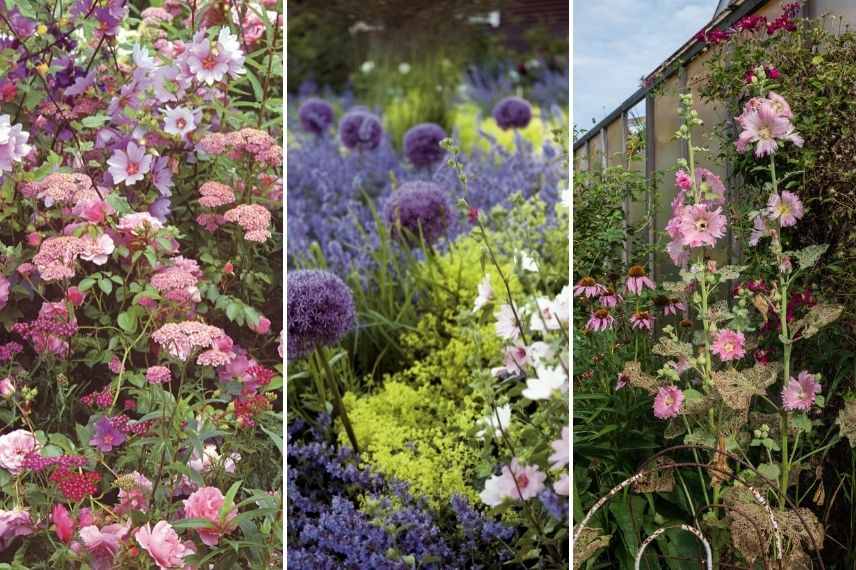
With its natural and delicate appearance, despite its vigour, the lavatera remains the queen of romantic gardens of yesteryear
According to the colour of the flowers
Lavateras offer us stunning flowerings in white, pink, purple, and even bicolour. Elegant and with a natural style, they have simple flowers with small details inside that add to their charm. Some varieties are veined, while others are speckled with irregular spots or blotches. Most lavatera flowerings change throughout the season from white to fuchsia pink, passing through soft pink, as seen in the lovely lavatera ‘Barnsley baby’.
Here’s an overview of the different colours available.
White-flowered Lavateras
- Lavatera ‘First light’ is covered in lovely white flowers with pale pink centres. This plant quickly reaches a good metre in height and its somewhat wild appearance suits many garden styles.
- Lavatera ‘White angel’ produces flower spikes a metre high bearing large white flowers of 5 cm throughout the summer. It is a plant of beautiful stature and very bright, making an excellent backdrop for borders and can also be planted as a specimen.
- Lavatera ‘Frederique’ has a bushy, upright, and dense habit, reaching 1.80m in height and 1.50m in width. From June to September, it produces a multitude of lovely white flowers with rosy centres.
- Lavatera maritima offers a generous and prolonged flowering with cup-shaped blooms, typical of the Malvaceae, in a white washed with lilac pink, enhanced by a dark magenta centre with prominent fused stamens.

On the left, the immaculate flowers of lavatera ‘Frederique’, on the right, Lavatera ‘White angel’.
Pink-flowered Lavateras
- Lavatera olbia rosea bears small but abundant bright pink flowers from spring to autumn on sage green foliage.
- The flowers of Lavatera ‘Burgundy wine’ are also bright pink, but leaning towards wine red.
- The lavatera ‘Bredon springs’ offers a peachy pink and coppery flowering.
- Lavatera ‘Candy floss’, candy pink, gets its name in English from the sweet treat known as marshmallow.
-
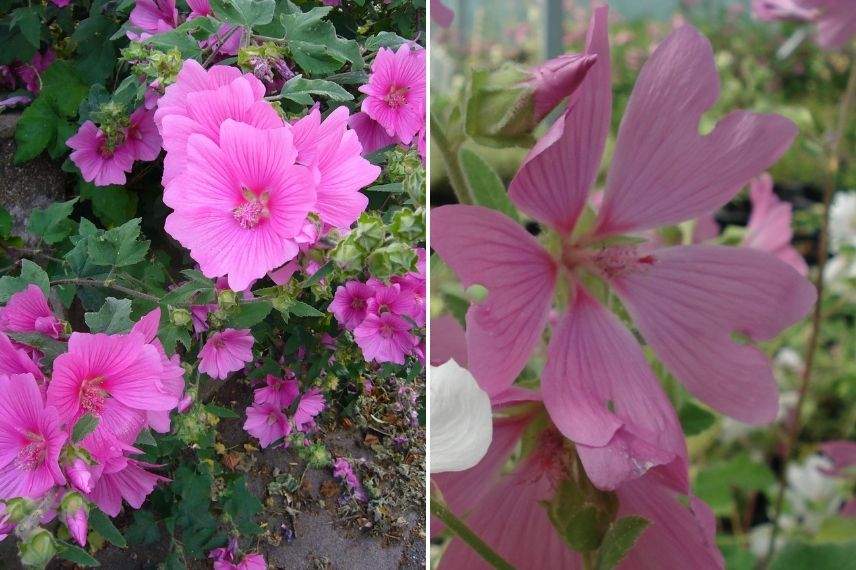
On the left, the deep pink of lavatera ‘Burgundy Wine’, on the right, the softer shade of Lavatera ‘Candy floss’.
Blue-flowered Lavateras
The bells of Lavatera ‘Blue bird’ bloom in ultramarine blue. The very light lower lip contrasts with the marbled brown throat, almost purple.
Bicolour-flowered Lavateras
- The flowers of Lavatera maritima ‘Bicolor’ bloom in cream. The very light lower lip contrasts with the marbled brown throat, nearly purple.
- The lavatera ‘Frederique’ produces flowers with a white corolla and a throat speckled or veined with soft pink.

On the left, a detail of Lavatera maritima ‘bicolor’, on the right, Lavatera ‘Frederique’.
According to the dimensions
Lavateras are fast-growing and vigorous bushes. They reach their maximum height by the second year. They can be classified into two groups.
Medium – between 1m and 1.20m tall
There are certain varieties whose height ranges from 1m to 1.30m, but these are the rarest. With their soft and graceful trailing habit under the weight of the flowers, they are ideal for borders. For example, Lavatera maritima, a modest bush with silvery-grey fuzzy leaves, does not exceed 1m. The Thuringian lavatera Lavatera thuringica ‘Barnsley baby’ with a height of about 1.50m does not exceed 1.20m in spread.
Large – minimum 1.40m up to 2m tall
The Hyères lavatera Lavatera olbia stands at nearly 2m. It can reach 3 to 4m on a small ramified trunk in Mediterranean areas. The lavatera thuringica ‘Frédérique’ and ‘Bredon springs’ are the largest, reaching 1.50m to 2m tall.
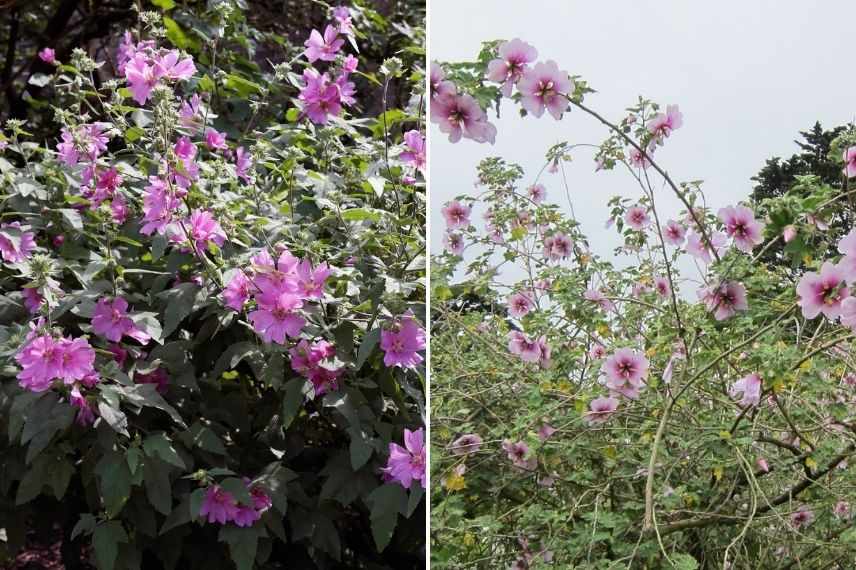
Lavateras quickly enliven garden borders thanks to their rapid growth.
Discover other Lavatera - Tree Mallow
View all →Available in 2 sizes
Available in 0 sizes
Available in 2 sizes
Available in 1 sizes
Available in 1 sizes
Available in 1 sizes
Available in 1 sizes
Available in 1 sizes
Available in 1 sizes
Available in 1 sizes
According to the foliage
The foliage of lavateras is deciduous or semi-evergreen. It is generally grey-green and downy. Some varieties have a bright green foliage such as the Hyères lavatera. The Spanish lavatera Lavatera maritima, suited to coastal areas, is drought-resistant thanks to its tomentose grey-white foliage. It limits water loss from the plant during periods of severe drought. Thelavatera has a relatively short lifespan of 5 to 7 years at most. Pruning is essential; otherwise, the plant exhausts itself trying to sustain all its branches and leaves.
Depending on the pH and the type of soil
All types of ordinary soils are suitable for lavateras, but they prefer draining soils with a tendency towards lime. Above all, lavatera fears stagnant moisture in clayey and suffocating soils in which it will not survive. Sea lavateras tolerate salinity. Their rapid, vigorous growth and great floribundity mean that lavateras need to be regularly watered and fed during the season, especially those grown in pots.
⇒ Eric’s advice: Be careful with overly rich soils, where lavatera will thrive but will develop a lot of foliage at the expense of flowering.
According to their hardiness
In general, lavateras are not considered to be very hardy plants. Native to the Mediterranean basin, they do, however, offer good resistance to sea spray. To address this lack of hardiness, new varieties have been introduced to the market. Hardier varieties such as Lavatera ‘Blushing bride’ or Lavatera thuringiaca ‘Burgundy wine’, can withstand temperatures down to -10/-12 °C. Overwintering lavateras in the garden can be achieved by severely pruning the stems and applying a good layer of leaf mulch. Following this treatment, they will thrive again in the following season, branching out to produce even more flowers.
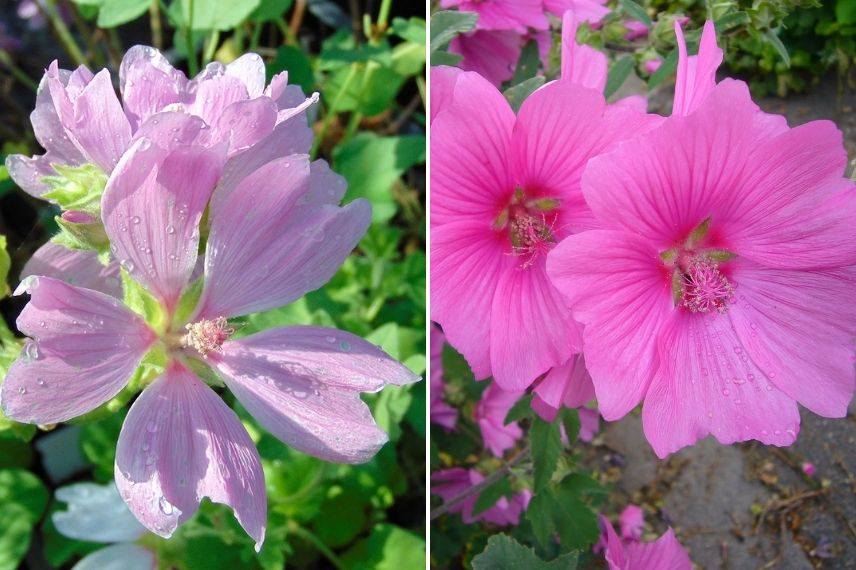
On the left: lavatera ‘Blushing bride’, on the right: ‘Burgundy wine’
It is worth noting that some varieties, derived from Lavatera trimestris, are not very hardy and are grown as annual plants in our climates. Very floriferous, annual lavateras are sown in spring, and the flowers renew abundantly throughout the summer.
Depending on the use
To flower a terrace
It is possible to grow lavatera in a large pot or container. The Lavatera thuringiaca ‘Burgundy Wine’ grows quickly, but in a size perfectly suited for balcony or terrace cultivation, reaching 100 to 150 cm in height and 120 cm in width. Remember to add a good layer of drainage at the bottom of the pot. In cold or damp climates, provide winter protection for the plant (fleece) and mulch at the base. If frosts persist, move your lavatera into a cold greenhouse or a sufficiently bright conservatory.
In a border
The largest lavateras should be placed at the back, such as Lavatera Olbia rosea. Smaller varieties, reaching about 80 cm to 120 cm in height, include Lavatera thuringiaca ‘Barnsley baby’, vigorous and very floriferous for low borders or flowering pathways. Lavatera thuringiaca ‘First light’ with its dark green foliage and immaculate white flowers can be positioned further forward. These lavateras create beautiful mixed borders in a natural style, surrounded by shorter plants to highlight their long flowering periods that attract butterflies and bees. They add volume to borders without weighing them down. At the start of the growing season, around March, cut all the branches of your lavatera to 10-15 cm above the ground. The new shoots will then be able to develop more easily and will bear many larger and more colourful flowers.

The lavatera ‘Barnsley baby’, a very floriferous compact bush for small spaces.
To flower a slope or rockery by the sea
Lavateras thrive in all types of soil as long as it is well-drained and they receive plenty of sunlight. Install Lavatera maritima and the Hyères lavatera Lavatera olbia ‘Rosea’, which are resistant to sea spray. Alternatively, choose a smaller, particularly vigorous and wind-resistant lavatera like Lavatera thuringiaca ‘Bredon springs’. This is a dense bush that produces a multitude of simple flowers, in a strong mauve-pink colour, from June to September. Its deciduous to semi-evergreen foliage, which is quite dark green, will persist through winter in mild climates. Ensure they have space (1.20 m in all directions) as they spread as much as they grow in height.
- Subscribe!
- Contents
































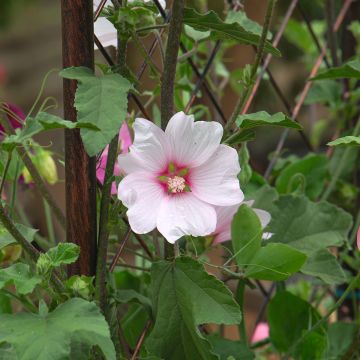
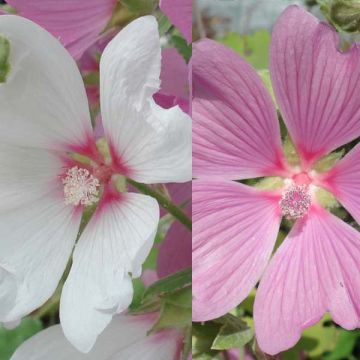

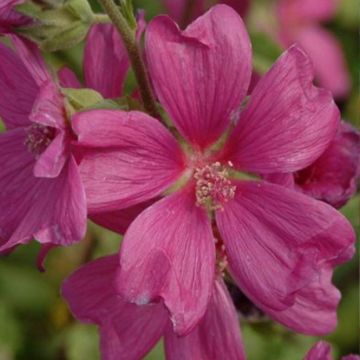

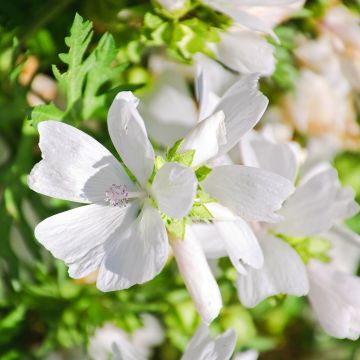
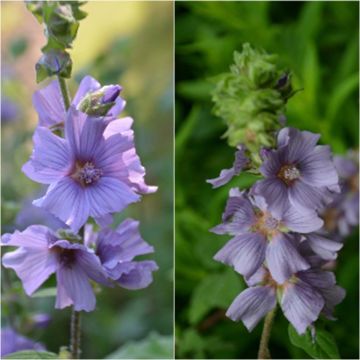
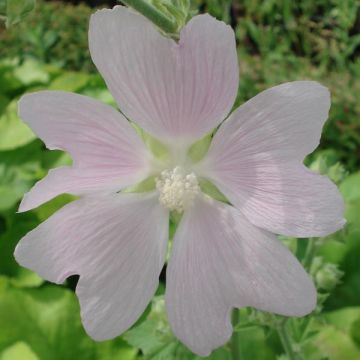
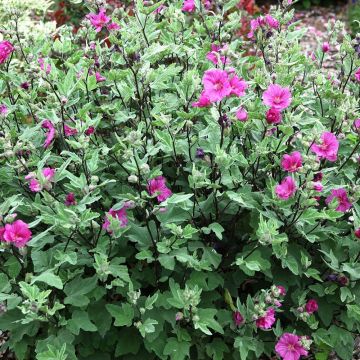

Comments